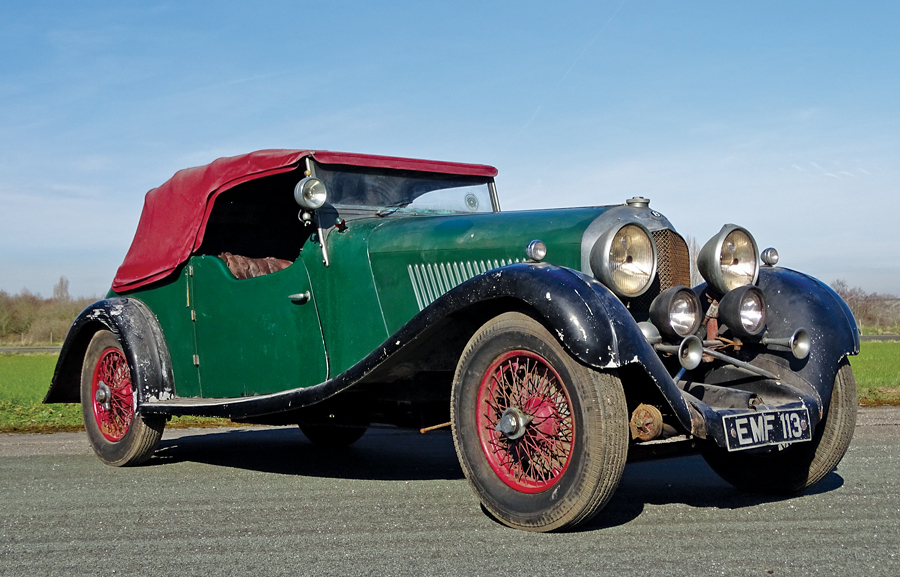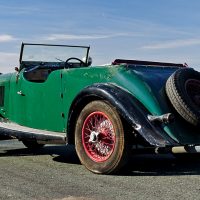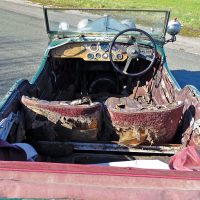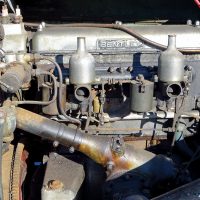SCM Analysis
Detailing
| Vehicle: | 1936 Bentley 4½ Litre Vanden Plas Tourer |
| Years Produced: | 1936 (factory Bentley 4½ Litre cars were made from 1927 to 1931) |
| Number Produced: | Six |
| Original List Price: | N/A |
| SCM Valuation: | $1,100,000 (for factory 4½ Litre cars) |
| Tune Up Cost: | $700 |
| Chassis Number Location: | Plate on firewall and on front engine cross member |
| Engine Number Location: | Stamped into engine bearer integral with crankcase |
| Club Info: | Bentley Drivers Club |
| Website: | http://www.bdcl.org |
| Alternatives: | 1924–29 Bentley 3/4½, 1922–27 Vauxhall OE30-98, 1930–33 Invicta S-type, 1933 Lagonda M45 |
| Investment Grade: | B |
This car, Lot 72, sold for $584,774, including buyer’s premium, at H&H’s Imperial War Museum, Duxford, U.K., auction on March 20, 2019.
How ironic, given that so many vintage Bentleys are bitsas — assembled from parts coming from more than one car — that this is a bitsa built by the Works.
This is a Vintage Bentley — with a capital V, meaning pre-1931, as most “WO” Bentleys were — but it was put together in the post-Vintage era by Bentley itself.
Continuation cars are not a recent phenomenon.
A bit of Bentley bitsa history
When Rolls-Royce took over Bentley Motors Ltd. in 1931, a new Service Department was established to look after Bentley’s existing customers, many of whose cars were still under their five-year warranties.
Based at the Kingsbury Works, Hendon, North London, and staffed by ex-Cricklewood stalwarts such as Nobby Clarke (former Racing Team Manager) and Hubert Pike (ex-director), the new outfit inherited a large cache of New Old Stock and reconditioned parts.
Maintenance and repair work on WO Bentleys began to tail off during 1936, as the last of the five-year guarantees expired. To keep the Service Department busy — and no doubt themselves in jobs — Clarke and Pike came up with the idea of building 10 R.C. (Reconditioned Chassis) Series cars — six 4½ Litres and four 3 Litres.
That they were not constructed from all-new parts is evidenced by our subject car’s rear axle casing bearing the number FW2618… which relates to a showroom-demonstrator 6½ Litre that was first registered to marque savior and three-times Le Mans winner Captain Woolf Barnato.
Early life
RC41’s first owner, Colonel Guy Bedford, had it looked after by the Service Department until 1939, which included having it re-bored at 45,000 miles and fitted with Specialloid pistons, raising the compression ratio to approximately 6.75:1.
Stored during World War II, it was sidelined afterwards by a faulty gear train to its magnetos and water pump. Charles Blackham bought it in 1952 as a non-runner for £260. A talented engineer, Blackham soon had it running again with uprated water pump and ignition system converted to coil and magneto.
Mr. Blackham continued to tinker with his 4½. He sourced a pair of Lucas P100 headlights and Desmo auxiliary driving lights and fixed a plaque to the dashboard that reads: Speed Must Not Exceed 170 mph. It’s still there, along with the bespoke switch plate he devised.
Unhappy with the aesthetics of the Vanden Plas hood, Blackham devised his own frame that sat within the body when folded. He also shortened the gear and handbrake levers, lowered the radiator by three-quarters of an inch and fabricated a front valance panel. However, the core of the car remained as it left Hendon, and this is the form in which it appears today.
A restoration is needed
Dormant for 30 years, the car is now in need of restoration. The general appearance is tatty: The paint is tired, faded and chipped, with a scrape on the right rear wing, the radiator shell is beginning to tarnish, the carpets and seat backs are moth-eaten, the seat bases have collapsed, the dashboard timber is flaking and fading, and the speedo has lost its glass, with resultant corrosion within.
Preserving originality
Luckily, today’s market is attuned to the importance of very original cars, and there’s every hope that this one will be restored with this 83-year-old body.
Personally, I’d give it a damn good service, redo the seat bases, wipe it over with an oily rag and drive it.
But there is the danger that, given the amount of work likely to be needed, which may involve stripping the car to its chassis for a proper rebuild, the temptation to rebody it as a more attractive — and more saleable — Vanden Plas Le Mans replica will be too hard to resist.
A rebodied 4½ Litre — many started as saloons, and there aren’t many left — typically sells for $500,000-plus, while, as we have seen, very original cars still with their original coachwork can easily top $1 million.
This car was cheaper, which is understandable given that it’s not a true Cricklewood Bentley, and it’s wearing a slightly nondescript body nearer in looks to a Derby Bentley than the classic Le Mans style that we picture when we think of WO and his cars.
But our subject car looked expensive when you compare it with the super — and very original — 1929 4½ Vanden Plas tourer that Bonhams sold at Goodwood the following month, which was worth every penny of the $618,818 paid. Significantly, H&H only estimated RC41 at £200k ($265k), tops.
For now, as the catalog had it, this is the ultimate “barn find” Bentley 4½ Litre in the marque’s centenary year. ♦
(Introductory description courtesy of H&H.)






